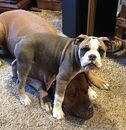Tonight Blossom was playing on the floor with her ball, and my son suddenly jumped up, and tried to take something out of her mouth, but she was too quick and swallowed a piece of her ball that she had chewed off. I went online and read how to induce vomiting in a dog, and it said to give 1 teaspoon for every 10 pounds of weight up to 50 lbs, wait 15 minutes, and if it doesn't induce vomiting, then repeat one more time, but do not exceed two times. I gave Blossom 3 teaspoons, even though she weighs 45 lbs, and waited, after about 5 minutes, she threw up about a cup of her food from dinner, but no rubber ball piece. I debated on whether I should give her the second dose, after waiting 15 minutes, but decided against it, as I have never given peroxide before, and didn't want to give her too much, or make her too sick. I was nervous about trying this, but it worked. About 20 minutes after I had given her the hydrogen peroxide she was lying beside me on the couch ( thank goodness for leather) and she threw up again, a little more than the first time and sure enough the little piece of ball came up. Thank goodness. I thought I would try it since it wasn't a really big piece, so wasn't too worried that she would choke on it, but I was nervous still. I'm just glad that it worked. I swear these bullies will be the death of us. They never learn not to swallow stuff.
May 23, 2013
How to ... Make a Dog Vomit
by Dr. Jennifer Coates, DVM
21
Up next in our “How to” series, inducing emesis in dogs, or in laymen’s terms, making a dog vomit.
Dogs are scavengers and have the maddening tendency to find and eat the things in their environments that are destined to make them the most sick. Human medications, pet medications, insecticides, cleaning products, fertilizer, weed killer, poisonous plants, pesticides, potentially toxic human foods (e.g., chocolate, grapes/raisings, xylitol) … you name it and a dog has probably eaten it.
In some cases, the first line of treatment is to get the offending substance out of the dog before it can cause too much damage. I say “some cases” because there are other times when inducing emesis is useless or potentially catastrophic. For example, dogs are typically only able bring up an offending substance within two hours or so of ingestion, and when a dog is not fully alert or when it has ingested a caustic or petroleum-based substance, vomiting will make the situation worse rather than better.
Therefore, owners should never attempt to make their dogs vomit without first consulting with a veterinarian. If a local veterinarian is not immediately available, call the ASPCA’s Animal Poison Control Center (888-426-4435) or the Pet Poison Helpline (855-213-6680). Both hotlines are staffed 24 hours a day, 7 days a week and are available to owners at a small charge.
Supplies Needed
Telephone
Phone number for veterinarian, ASPCA’s Animal Poison Control Center (888-426-4435), or the Pet Poison Helpline (855-213-6680)
3% Hydrogen Peroxide, available at any drug store or supermarket
A large syringe (no needle) or turkey baster
Measuring teaspoon
Latex or rubber gloves, paper towels, water, cleaning solution, and plastic bags
Steps to Follow
Call your veterinarian or pet poison control center/hotline. Have as much of the following information ready as possible: your dog’s approximate weight, any health problems the dog suffers from, what he may have eaten, when he may have eaten it, and the amount potentially involved. If you are instructed to induce emesis at home, proceed. Otherwise follow the directions given to you by the veterinarian you have spoken with.
If the dog has not eaten within the last two hours, offer him a small meal. This makes it more likely that the dog will vomit but is not essential if the dog is uninterested in food.
Measure 1 milliliter (ml) of 3% hydrogen peroxide per pound of dog weight, using either the syringe or teaspoon. One teaspoon is approximately five ml. The maximum amount of hydrogen peroxide to be given at any one time is 45 ml, even if a dog weighs over 45 pounds.
Squirt the hydrogen peroxide into the back of the dog’s mouth using the syringe or turkey baster.
If vomiting has not occurred within 15 minutes or so, give one more dose of hydrogen peroxide measured out as described above. If vomiting still does not occur, call your veterinarian or the pet poison control center/hotline back for instructions.
Once vomiting has occurred, collect a sample in a leak-proof container to bring to your veterinarian’s office for identification if you are unsure of exactly what your dog may have eaten.
Thoroughly clean up the vomit. Wear latex or rubber gloves while handling vomit, particularly if it potentially contains a material that is hazardous to human health.
Unless instructed otherwise by your veterinarian or the pet poison control center/hotline, take the dog to a veterinary clinic immediately for evaluation and continued treatment.
May 23, 2013
How to ... Make a Dog Vomit
by Dr. Jennifer Coates, DVM
21
Up next in our “How to” series, inducing emesis in dogs, or in laymen’s terms, making a dog vomit.
Dogs are scavengers and have the maddening tendency to find and eat the things in their environments that are destined to make them the most sick. Human medications, pet medications, insecticides, cleaning products, fertilizer, weed killer, poisonous plants, pesticides, potentially toxic human foods (e.g., chocolate, grapes/raisings, xylitol) … you name it and a dog has probably eaten it.
In some cases, the first line of treatment is to get the offending substance out of the dog before it can cause too much damage. I say “some cases” because there are other times when inducing emesis is useless or potentially catastrophic. For example, dogs are typically only able bring up an offending substance within two hours or so of ingestion, and when a dog is not fully alert or when it has ingested a caustic or petroleum-based substance, vomiting will make the situation worse rather than better.
Therefore, owners should never attempt to make their dogs vomit without first consulting with a veterinarian. If a local veterinarian is not immediately available, call the ASPCA’s Animal Poison Control Center (888-426-4435) or the Pet Poison Helpline (855-213-6680). Both hotlines are staffed 24 hours a day, 7 days a week and are available to owners at a small charge.
Supplies Needed
Telephone
Phone number for veterinarian, ASPCA’s Animal Poison Control Center (888-426-4435), or the Pet Poison Helpline (855-213-6680)
3% Hydrogen Peroxide, available at any drug store or supermarket
A large syringe (no needle) or turkey baster
Measuring teaspoon
Latex or rubber gloves, paper towels, water, cleaning solution, and plastic bags
Steps to Follow
Call your veterinarian or pet poison control center/hotline. Have as much of the following information ready as possible: your dog’s approximate weight, any health problems the dog suffers from, what he may have eaten, when he may have eaten it, and the amount potentially involved. If you are instructed to induce emesis at home, proceed. Otherwise follow the directions given to you by the veterinarian you have spoken with.
If the dog has not eaten within the last two hours, offer him a small meal. This makes it more likely that the dog will vomit but is not essential if the dog is uninterested in food.
Measure 1 milliliter (ml) of 3% hydrogen peroxide per pound of dog weight, using either the syringe or teaspoon. One teaspoon is approximately five ml. The maximum amount of hydrogen peroxide to be given at any one time is 45 ml, even if a dog weighs over 45 pounds.
Squirt the hydrogen peroxide into the back of the dog’s mouth using the syringe or turkey baster.
If vomiting has not occurred within 15 minutes or so, give one more dose of hydrogen peroxide measured out as described above. If vomiting still does not occur, call your veterinarian or the pet poison control center/hotline back for instructions.
Once vomiting has occurred, collect a sample in a leak-proof container to bring to your veterinarian’s office for identification if you are unsure of exactly what your dog may have eaten.
Thoroughly clean up the vomit. Wear latex or rubber gloves while handling vomit, particularly if it potentially contains a material that is hazardous to human health.
Unless instructed otherwise by your veterinarian or the pet poison control center/hotline, take the dog to a veterinary clinic immediately for evaluation and continued treatment.
Last edited:





